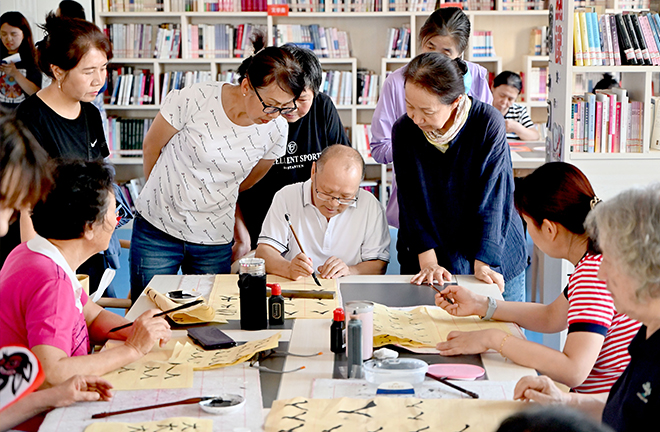Promoting elderly education in China

Students learn calligraphy at a community college for the elderly in Hohhot, Inner Mongolia Autonomous Region. Photo: Liu Wenhua/CNSphoto
In China, actively responding to population aging is a comprehensive and strategic task that necessitates coordinated efforts across various fields. China has formulated several national education strategies which encompass basic, higher, and adult education. However, there is currently no specific national education strategy aimed at addressing population aging. It is worth noting that a national strategy for elderly education can play a significant role in actively responding to population aging.
Strategic system
China can draw valuable lessons from the coping strategies of developed countries that have already entered the stage of population aging. However, given the considerable differences in political environment, institutional development, and social reality between developed countries and China, it would be unwise for China to simply imitate their practices. Instead, China needs to focus on the development of a localized national strategy for elderly education based on a global perspective.
A national strategy for elderly education with Chinese characteristics mainly involves the following aspects. First, elderly education in China needs further structural adjustment and optimization to enjoy equal status with basic education and higher education in the Chinese education system. Second, policies and regulations regarding elderly education need to be further adapted and innovated to make them more precise and effective. Third, it is necessary to further construct and improve support systems for elderly education to meet the educational needs of senior Chinese citizens.
Specifically, the following four elements should be clarified: the educational needs and motivations of different groups within the elderly population; the desired educational content of each group; the levels, categories, disciplines and majors, forms and structures of elderly education; the position of the elderly education strategy and its compatibility with social development.
Concept and perspective
A national strategy for elderly education that actively addresses population aging needs to be underpinned by a new philosophy. It should not only adhere to the vision of innovative, coordinated, green, open and shared development, but also advocate the concepts of lifelong learning, holistic education, active aging, filial piety, green service, and health education in the interests of the elderly. This will help develop modern elderly education characterized by lifelong development, multi-stakeholder engagement, active participation, provision of elderly care, and healthy aging. Holistic development based on the life cycle of the elderly requires strong family support systems which encompass various aspects, such as learning activities and daily life.
In addition to considering the perspectives of senior citizens and their families, the educational development needs of the elderly should also be examined from national and societal perspectives. At the national level, it is important to analyze the overall goals and strategies of elderly education reform and development within a certain period, and optimize the national policy and legal system for elderly education. At the societal level, efforts should be made to actively build an elderly-friendly society in terms of stakeholders, organizations, and resources, starting from social welfare.
A national strategy for elderly education can generate cognitive, relational, and structural value for the elderly. Cognitive value refers to the enhancement of the cognitive abilities of the elderly empowered by education. Relational value refers to the formation of new relationships between elderly individuals, their children, and other members of society through educational interaction. Structural value refers to the improvement of the status of the elderly and their increased role in educational interaction.
This strategy can generate organizational and service value for elderly education institutions. Organizational value lies in enhanced service awareness of these institutions and the increased organizational benefits they create for the development of an aging society. Service value arises from the provision of elderly educational services in the new era of population aging and the improvement of service capabilities of various institutions, particularly elderly education institutions, in society.
Liu Xu and Zhao Min (professor) are from the School of Politics and Public Administration at South China Normal University.
Edited by WANG YOURAN

 PRINT
PRINT CLOSE
CLOSE